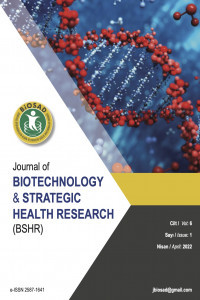Nadir Bir Bakteriye Bağlı Pnömoni: Pediatrik Bir Hastada Chryseobacterium Indologenes Enfeksiyonu
Chryseobacterium indologenes, Bakteriyemi, Pnömoni
Pneumonia Due to a Rare Bacteria: Chryseobacterium indologenes Infection in a Paediatric Patient
Chryseobacterium indologenes, Bacteremia, Pneumonia,
___
- 1. Lin JN, Lai CH, Yang CH, Huang YH, Lin HF and Lin HH. Comparison of four automated microbiology systems with 16S rRNA gene sequencing for identification of Chryseobacterium and Elizabethkingia species Scientific Reports 2017 23;7(1):13824.
- 2. Mukerji R, Kakarala R, Smith SJ, Kusz HG. Chryseobacterium indologenes: an emerging infection in the USA. BMJ Case Rep. 2016. pii: bcr2016214486.
- 3. Antonello VS, Daht P, Polli J, Gross M and Colvero M. Ventilator-Associated Pneumonia In Neonatal Intensive Care Unit Due To Chryseobacterium Indologenes. The Pediatric Infectious Disease Journal 2017 36(12):353-355.
- 4. Jeffrey T. Kirby, Helio S. Sader,Timothy R. Walsh, Ronald N. Jones. Antimicrobial Susceptibility and Epidemiology of a Worldwide Collection of Chryseobacterium spp.: Report from the SENTRY Antimicrobial Surveillance Program (1997–2001). J Clin Microbiol. 2004 ;42(1):445-8.
- 5. Du Moulin GC. Airway colonization by Flavobacterium in an intensive care unit. J. Clin. Microbiol 1979 10:155–160.
- 6. Hoque SN, Graham J, Kaufmann ME, Tabaqchali S. Chryseobacterium (Flavobacterium) meningosepticum outbreak associated with colonization of water taps in a neonatal intensive care unit. J. Hosp. Infect. 2001 47:188–192.
- 7. Mehta R and Pathak A. Emerging Chryseobacterium indologenes Infection in Indian Neonatal Intensive Care Units: A Case Report. Antibiotics 2018, 7, 109.
- 8. Chang YC, Lo HH, Hsieh HY, Chang SMI. dentification, epidemiological relatedness, and biofilm formation of clinical Chryseobacterium indologenes isolates from central Taiwan. J Microbiol Immunol Infect. 2015;48:559–64.
- 9. Hsueh PR, Hsiue TR, Wu JJ, Teng LJ, Ho SW, Hsieh WC et al. Flavobacterium indologenes bacteremia: Clinical and microbiological characteristics. Clin. Infect. Dis 1996 23, 550–555.
- 10. Bloch KC, Nadarajah R, and R. Jacobs. Chryseobacterium meningosepticum: an emerging pathogen among immunocompromised adults. Repor of 6 cases and literature review. Medicine (Baltimore) 1997 76:30–41.
- 11. Sader HS, Jones RN, and Pfaller MA. Relapse of catheterrelated Flavobacterium meningosepticum bacteremia demonstrated by DNA macrorestriction analysis. Clin. Infect. Dis 1995 21:997–1000.
- 12. Kirby JT, Sader HS, Walsh TR. Antimicrobial susceptibility and epidemiology of a worldwide collection of Chryseobacterium spp: report from the SENTRY Antimicrobial Surveillance Program (1997–2001). J of Clin Microbiol 2004;42:445–8.
- 13. Fraser SL, Jorgensen JH. Reappraisal of the antimicrobial susceptibilities of Chryseobacterium and Flavobacterium species and methods for reliable susceptibility testing. Antimicrob Agents Chemother 1997;41:2738–41.
- 14. Maravic A, Skocibusic M, Samanic I, Puizina J. Profile and multidrug resistanc determinants of Chryseobacterium indologenes from seawater and marine fauna. World J Microbiol Biotechnol 2013;29:515–22.
- 15. Afshar M, Nobakht E, Lew SQ. Chryseobacterium indologenes peritonitis in peritoneal dialysis. BMJ Case Rep. 2013: pii: bcr2013009410.
- 16. Green BT, Nolan PE. Cellulitis and bacteraemia due to Chryseobacterium indologenes. J Infect 2001;42:219–20.
- 17. Cone LA, Morrow AA, Benson M, et al. Chryseobacterium indologenes sepsis due to an infected central catheter in a patient with metastatic breast cancer to the skin. Infect Dis Clin Pract 2007;15:403–5.
- 18. Al-Tatari H, Asmar BI, Ang JY. Lumboperitonial shunt infection due to Chryseobacterium indologenes. Pediatr Infect Dis J. 2007;26:657–9.
- 19. Kilvington S, Shovlin J, Nikolic M. Identification and susceptibility to multipurpose disinfectant solutions of bacteria isolated from contact lens storage cases of patients with corneal infiltrative events. Cont Lens Anterior Eye 2013;36:294–8.
- 20. Sudharani V, Asiya, Saxena NK. Chryseobacterium indologenes bacteraemia in a preterm baby. Indian J Med Microbiol. 2011;29:196–8.
- 21. Lin JN , Teng SH, Lai CH , Yang CH , Huang YH et al. Comparison of the Vitek MS and Bruker Matrix-Assisted Laser Desorption Ionization–Time of Flight Mass Spectrometry Systems for Identification of Chryseobacterium Isolates from Clinical Specimens and Report of Uncommon Chryseobacterium Infections in Humans. J of Clin Microbiol. 2018, 56 (11) 00712-18
- Yayın Aralığı: Yılda 3 Sayı
- Başlangıç: 2017
- Yayıncı: Deneysel, Biyoteknolojik, Klinik ve Stratejik Sağlık Araştırmaları Derneği
Özkıyım Girişimi Nedeni ile Çocuk Acil Servise Başvuran 18 Yaş Altı Hastaların Değerlendirilmesi
Pitriyazis Rosea Olgularında Otoimmün Belirteçlerin Araştırılması
Bahar SEVİMLİ DİKİCİER, Güneş GÜR AKSOY
Anti-HIV ½ Reaktif Saptanan Hastaların Doğrulama Test Sonuçları İle Birlikte Değerlendirilmesi
Hande TOPTAN, Ferhat Gürkan ASLAN, Engin KARAKEÇE, Özlem AYDEMİR, Tayfur DEMİRAY, Mehmet KÖROĞLU, Oğuz KARABAY, Mustafa ALTINDİŞ
Nadir Bir Bakteriye Bağlı Pnömoni: Pediatrik Bir Hastada Chryseobacterium Indologenes Enfeksiyonu
Tayfur DEMİRAY, Tuğba AYHANCI, Hüseyin HATİPOĞLU, Halime ÇİÇEK, Mehmet KÖROĞLU, Mustafa ALTINDİŞ
Antimikrobiyal Peptidlerin Sepsis Tanısındaki Rolü
Tuğba AYHANCI, Mustafa ALTINDİŞ
Pnömotoraks ile Seyreden İnsan Metapnömovirüs Pnömonisi
Gülsüm KAYA, Rasime Öznur HALİCİ, Metin ÇOBAN, Şeyma TRABZON, Selma ALTINDİŞ
